Kuvasz
Canis lupus
Ownership of this dog was once restricted to the Hungarian nobility
Advertisement
Kuvasz Scientific Classification
- Kingdom
- Animalia
- Phylum
- Chordata
- Class
- Mammalia
- Order
- Carnivora
- Family
- Canidae
- Genus
- Canis
- Scientific Name
- Canis lupus
Read our Complete Guide to Classification of Animals.
Kuvasz Conservation Status
Kuvasz Facts
- Fun Fact
- Ownership of this dog was once restricted to the Hungarian nobility
- Temperament
- Brave, loyal, and fearless
- Diet
- Omnivore
Kuvasz as a Pet:
- General Health
- Energy Level
- Shedability
- Trainability
- Intelligence
- Tendency to Chew
- Size
- Family and kid friendliness
- Yappiness / Barking
- Moderate
- Separation Anxiety
- Moderate
- Preferred Temperature
- Cold climate
- Exercise Needs
- High
- Friendly With Other Dogs
- Moderate
- Pure bred cost to own
- $1,200 to $1,500 on average
- Dog group
- Working
- Male weight
- 100-115 lbs
- Female weight
- 70-90 lbs
This post may contain affiliate links to our partners like Chewy, Amazon, and others. Purchasing through these helps us further the A-Z Animals mission to educate about the world's species.
View all of the Kuvasz images!
The name Kuvasz is believed to a Hungarian form of the Turkish word kawasz, meaning the armed guard of the nobility.
The Kuvasz (pronounced koo-vahz) is a big, strong Hungarian working dog whose main task was originally to guard livestock. The more recent history of this breed dates back to the late 800s when the nomadic Magyars (the ancestors of modern Hungarians) settled in the Carpathian Basin. They brought with them large working dogs from the east, possibly as far as Tibet. Although this breed is associated with Hungary, this is an ancient breed that can be traced back to Mesopotamia where the name “ku-assa” was found inscribed on clay boards. This word means dog horse.
See all of our expert product reviews.
These dogs were initially popular among livestock owners, but as their notoriety grew, ownership was eventually restricted to the nobility. It took until the 19th century before anyone established a breed standard. Although the Kuvasz was recognized by the American Kennel Club in 1931, the following decades brought devastation to its native land of Hungary. Only 30 dogs were salvaged from the wreckage of World War II when it was deliberately targeted by invading soldiers. Today, after decades of dedicated breeding, the Kuvasz is prized as both a companion and guard dog.
The Kuvasz is characterized by a wedge-shaped head, almond-shaped eyes, and drooping ears. The luxurious all-white consists of two layers: outer guard hairs and a finer undercoat. This makes it very thick and somewhat coarse to the touch.
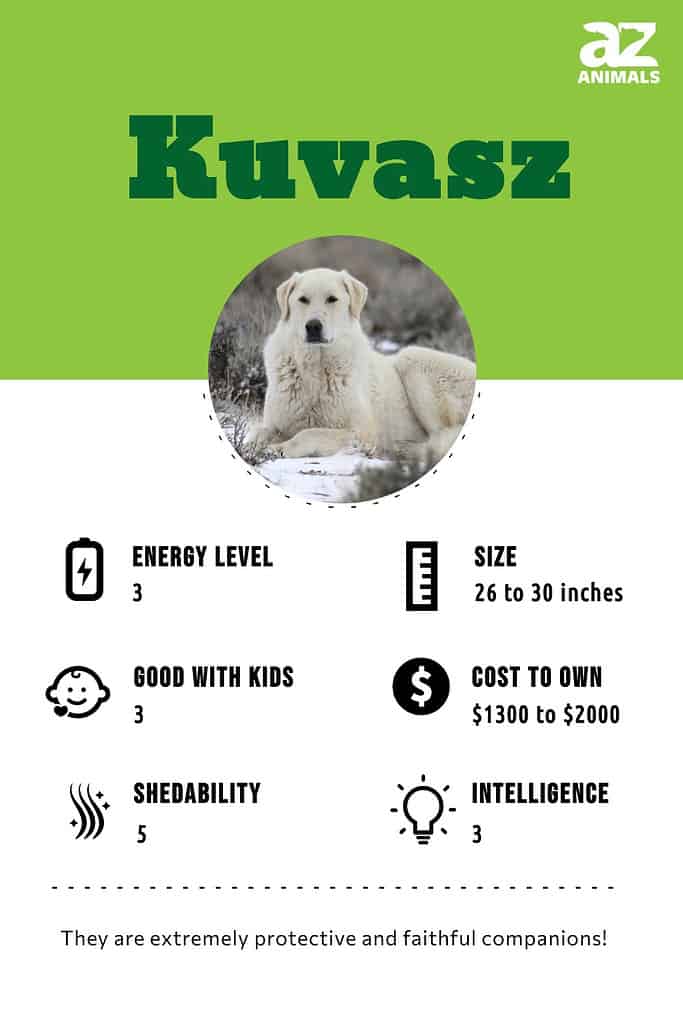
Kuvasz Vs Great Pyrenees
Despite their very different geographical range (the Great Pyrenees, as the name suggests, originated near the Pyrenees region of southern France), the two breeds are thought to be very closely related. Both of them have big bodies, thick white fur, and protective personalities. The main difference is that the Great Pyrenees has a wider head, heavier bones (thus more cumbersome movement), patches of gray or tan fur, and a double dew claw on the hind foot.
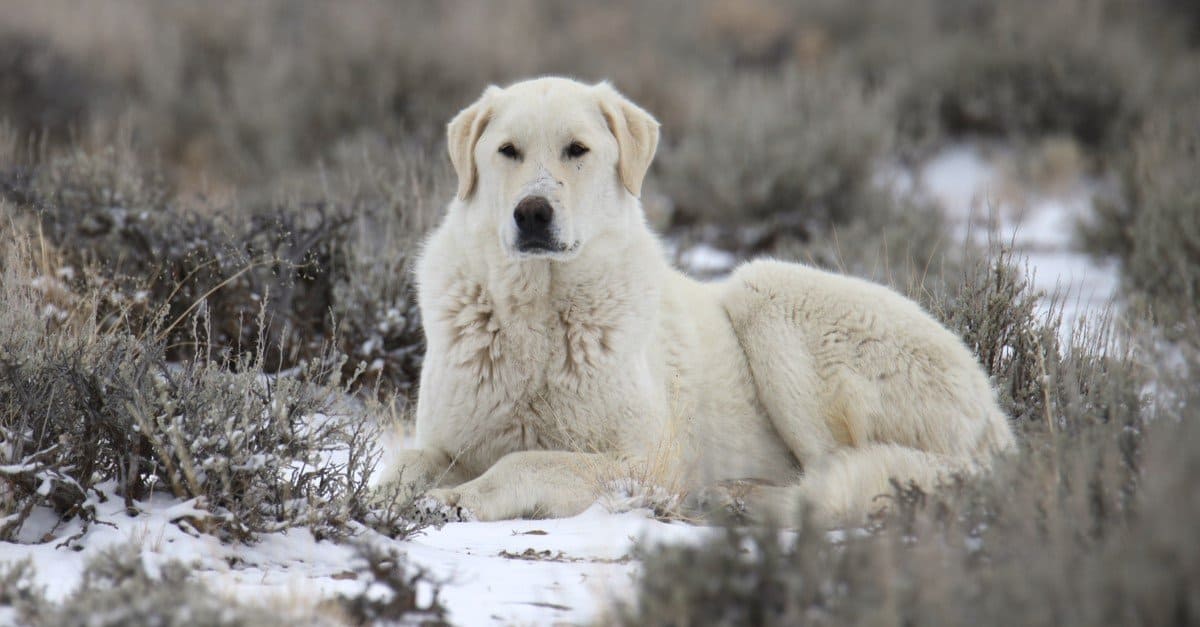
The Kuvasz’ luxurious fur consists of two layers.
©vagabond54/Shutterstock.com
Health and Entertainment for your Kuvasz
See all of our expert product reviews.
3 Pros And Cons Of Owning A Kuvasz
| Pros! | Cons! |
|---|---|
| Excellent Guard Dog The Kuvasz has personality traits suitable for guard duty, including courage, strength, and alertness. | Wary of Strangers The Kuvasz can be very suspicious of unfamiliar people. |
| Exceptionally Strong This breed is a great choice for people who need a working dog. | Independent Streak This breed has a very strong mind of its own. |
| Intelligent The Kuvasz is very quick to learn human commands. | High Maintenance These dogs will demand a lot of time and attention from their owners. |
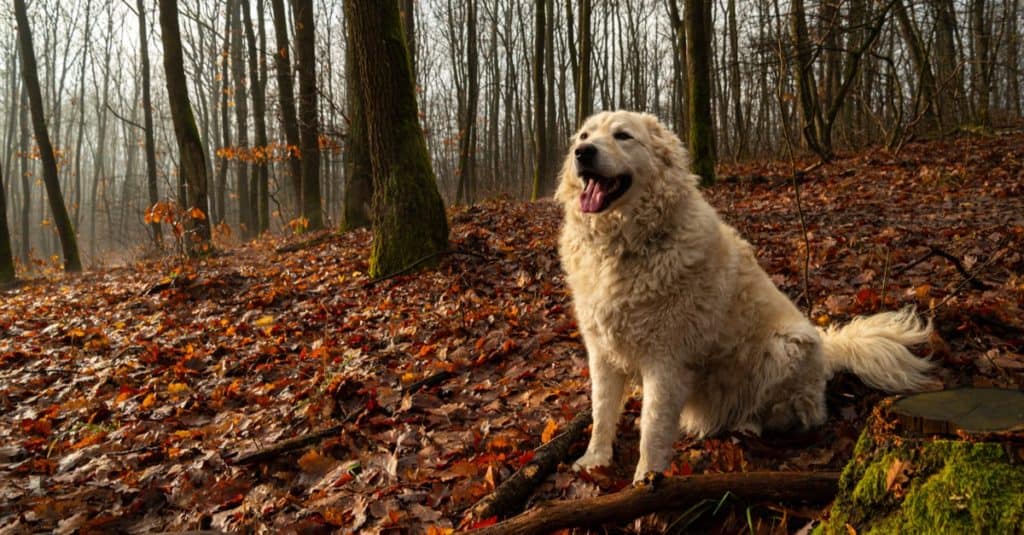
Hungarian Kuvasz shepherd dog is a great working dog.
©Pelle Zoltan/Shutterstock.com
Size And Weight
The Kuvasz is a big, burly dog with a muscular frame. Males tend to be significantly larger than females.
| Height (Male) | 28 to 30 inches |
| Height (Female) | 26 to 28 inches |
| Weight (Male) | 100 to 115 pounds |
| Weight (Female) | 70 to 90 pounds |
Common Health Issues
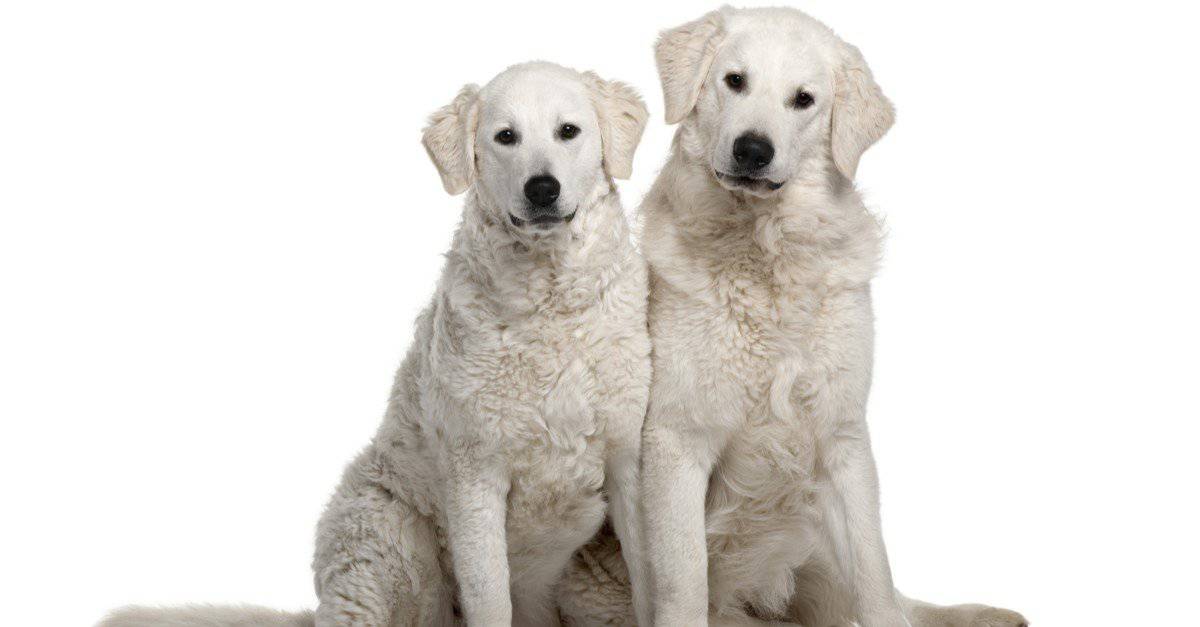
Always take your dog to the vet for regular checkups and look for genetic conditions.
©Eric Isselee/Shutterstock.com
While generally healthy, the Kuvasz may be prone to several serious conditions, including bloating, cataracts, cancer, hip dysplasia, a bleeding disorder called Von Willebrand’s disease, and a degenerative bone condition called Osteochondritis Dissecans.
The life expectancy for this breed is 10 to 12 years. To maximize the chances of a long and healthy life, there are a few things you can do. First, the quality of the breeder always matters. Ask the breeder for proof that their dogs have been screened for common genetic health disorders and do not settle for less. Second, you should find a good vet in your area and schedule regular checkups. In summation, these are the most common health problems:
- Cataracts
- Bloating
- Cancer
- Hip Dysplasia
Temperament
The Kuvasz is a brave, spirited dog with a personality well-suited for work or guard duty. While a little wary and suspicious of strangers, this breed will also form a very strong bond with members of the family. Despite their enormous size, they are sensitive souls, very responsive to both praise and blame. They have an independent streak and may suddenly act on their own. This can be good if the situation calls for bold action, but not everyone may appreciate this behavior. Their barking is also relatively limited for a guard dog.
How To Take Care Of The Kuvasz

Kuvasz dogs will demand a lot of time and attention.
©La Su/Shutterstock.com
The Kuvasz is probably not a great choice for owners who want a simple low-maintenance companion. This is a pure working breed that will likely demand a lot of its owner’s time and attention. Likewise, it’s not really suitable for apartment living. Owners should ideally have a suitable house with a fenced yard. If you have any other questions or concerns about your dog’s care, then you should consult with your vet.
The Best Dog Food For The Kuvasz
The Kuvasz needs around 3 to 3.5 cups of high-quality dog food per day. This amount may change slightly based on your dog’s size, age, and activity level. Owners will need to be careful about how much they feed their dog because this breed does have a tendency to gain weight and experience bloating (a very serious and potentially life-threatening condition in which the stomach is unable to expel air). It’s a good idea to leave out only two meals a day and limit the number of snacks.
At A-Z Animals, we believe the best dog food for the Kuvasz is Purina Pro Plan Large Breed & Giant Breed Chicken & Rice Adult Dry Dog Food.
This food has everything huge dogs like the Kuvasz need from head to toe. Chicken, beef, and fish provide lots of protein as well as glucosamine, Omega-3s, and EPA to develop and sustain strong joints. Plus, the formula aids digestion, with natural prebiotic fiber to enhance gut bacteria. Plus, the taurine is key since the Kuvasz can develop cataracts.
Try out Purina Pro Plan Large and Giant Breed Dog Food on Chewy or Amazon.
- Crunchy kibble combined with tender, shredded pieces for taste and texture dogs love
- High protein formula, with real chicken as the first ingredient
- Fortified with guaranteed live probiotics for digestive and immune health
- Used to be known as SAVOR Shredded Blend Large Breed Formula
- Glucosamine and EPA, an omega-3 fatty acid, for joint health and mobility
Maintenance And Grooming
Despite its thick double coat and its tendency to shed, the Kuvasz only requires weekly grooming with a simple slicker brush or pin brush to remove loose hair and debris. If the fur becomes matted, then it might be a good idea to use a larger toothed comb and a conditioning spray to work out the mats. This should be combined with the occasional bath to clean out dirty fur. You should also trim the nails about once a month if they are not naturally worn down. Finally, brush its teeth with suitable toothpaste at least two or three times a week to prevent disease and bad breath.
Training

The Kuvasz has a tendency to act on its own and should receive early training.
©Jakab Flora/Shutterstock.com
The Kuvasz has earned great acclaim for its high intelligence and the speed at which it learns to perform lots of different tasks and human commands. That does not necessarily make them easy to train, however. This breed’s strong independent streak will probably assert itself often during the course of training.
Owners will need to exercise patience and consistency in their training methods to overcome the breed’s natural tendency to act on its own. There is unfortunately no easy way around this and early training is an absolute necessity with this breed. If you’re struggling to get a handle on the training process, then you might want to enlist the help of someone who really understands a dog like the Kuvasz.
Exercise
Given its enormous strength and power, it’s no surprise these big dogs need a lot of daily exercise to maintain proper physical health. Owners should ideally have a fenced yard to give them plenty of space for free roaming. They’re also good at sports, fetching, and agility challenges.
Puppies
Kuvasz pups will need rigorous training and socialization from the moment they’re brought home by the owner. Training will help with discipline, while socialization (like parties, dog parks, or doggie daycare) will help curb your dog’s natural suspicion of strangers.
Another important thing to keep in mind about Kuvasz pups is that they need plenty of time to adapt and grow physically. Owners should limit the length and intensity of exercise during the first year or even two of their lives. Running and jumping around on hard surfaces is particularly problematic and could lead to injuries. Finally, crate training is a good way to help your pups deal with anxiety and housetraining, though it’s not strictly necessary.
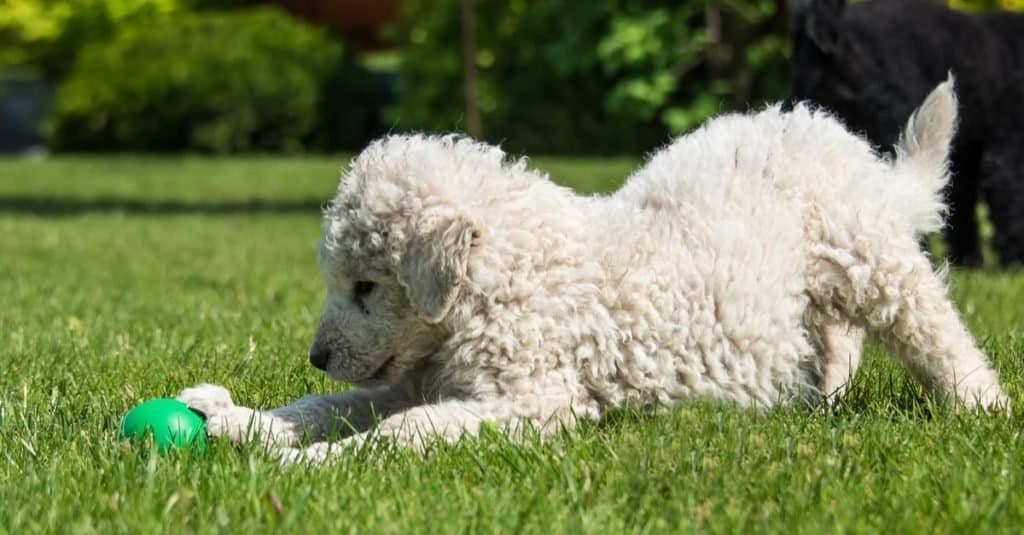
.
©Tom Kolossa/Shutterstock.com
The Kuvasz And Children
The Kuvasz is very friendly and protective toward younger members of the family, but keep in mind that it may mistake some child’s play as aggression. If your kid is playing with friends, for instance, then the dog may step in and think it’s protecting your child. Adults should supervise any and all interactions between dogs and kids.
Dogs Similar To The Kuvasz
If you are a fan of large working dogs, then you might want to consider one of the following breeds:
- Tibetan Mastiff – An ancient breed hailing from the Himalayas, the Tibetan Mastiff is a massive behemoth that sports a double coat of black or brown fur with white markings. For hundreds of years, it served as a herding dog and guardian out in the field and a watchdog in the monastery.
- Bernese Mountain Dog – Hailing from the Swiss region of Bern, this breed combines a loyal and protective demeanor with a calm and good-natured personality. This means it’s a little more suitable as a companion than some breeds of guardian dogs. It is characterized by the huge body, the drooping ears, the keen eyes, and the distinctive tri-colored coat (black body, white chest/face, and brown markings).
- St. Bernard – This is another giant working breed that originates from the Alps. Sporting a smooth or a rough coat with white and brown markings, this breed has a playful and charming personality that should appeal to people of all ages.
Famous Kuvasz Dogs
The Kuvasz is unfortunately not well-known outside of its native Hungary, but there are a few famous examples. Matthias Corvinus, a 15th-century king of Hungary and Croatia and certainly one of the most famous figures in the country’s history was said to keep a large number of these dogs in his court, sometimes trusting them more than his actual guards. More recently, the 1996 Disney film “Homeward Bound II: Lost in San Francisco” featured a supporting role from a Kuvasz named Delilah. She was voiced by the actress Carla Gugino in one of her earlier roles.
Popular Names For The Kuvasz
If you are still searching for an appropriate dog name, then you might want to consider the following options:
- Bella
- Penny
- Sammy
- Roxie
- Max
- Buddy
- Riley
- Apollo
- Charlie
- Lily
Kuvasz FAQs (Frequently Asked Questions)
What is a Kuvasz?
The Kuvasz is a big working and guard dog that first originated in Hungary during the Middle Ages. While very loyal and protective toward members of the family, this dog does have a natural suspicion of strangers. It also requires a lot of physical space and attention from its owner.
How much does a Kuvasz cost?
The normal price of a new Kuvasz puppy is usually somewhere around $1,200 to $1,500. From a top breeder, the price can easily exceed $2,000. If you’re intent on adoption, however, the price is usually a lot less. It might be possible to find this breed at a local adoption shelter, but these dogs are quite uncommon. You might have better luck with a Kuvasz-specific adoption group.
Are Kuvasz aggressive?
The Kuvasz can be a little aggressive toward strangers, but this behavior can be properly mitigated with proper training.
Is a Kuvasz the same as a Great Pyrenees?
The Great Pyrenees, also known as the Pyrenean Mountain Dog, is a separate breed of working dog that originated in southern France, but it does look and behave a lot like the Kuvasz. The two breeds are thought to be closely related.
Will a Kuvasz protect you?
Yes, the Kuvasz is one of the best guardian dogs an owner can buy.
What is the best environment for Kuvasz?
The Kuvasz should do best in spacious homes with enclosed yards. These large behemoths are not as well-suited for the cramped confines of apartment living.
What other breeds is the Kuvasz mixed with?
The Kuvasz has been mixed with Poodles, Labrador Retrievers, Border Collies, and German Shepherds to produce many interesting mixed breeds.
What is the difference between a Kuvasz and a Great Pyrenees?
At a glance, it can be hard to see any differences between these two large, loyal breeds. Both are livestock dogs with thick, light-colored coats with similarly protective personalities. However, even their similarities aren’t identical. The Kuvasz can come in a variety of shades of white, and it has more definitely textured fur than the Great Pyrenees.
What are the key differences between Kuvasz dogs and Maremma dogs?
The key differences between Kuvasz and Maremma are size, lifespan, temperament, trainability, grooming, energy level, shedding level, barking level, and bite force.
Thank you for reading! Have some feedback for us? Contact the AZ Animals editorial team.
Sources
- American Kennel Club, Available here: https://www.akc.org/dog-breeds/kuvasz/
- American Kennel Club, Available here: https://www.akc.org/expert-advice/lifestyle/5-things-you-didnt-know-about-the-kuvasz/
- Huron Kennels, Available here: http://huronkennels.com/kuvasz-vs-great-pyrenees/


















